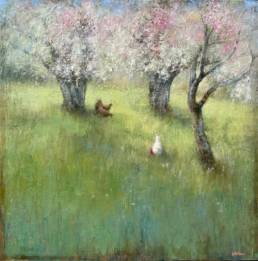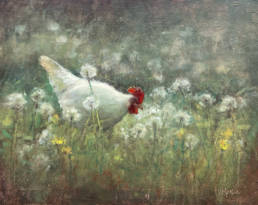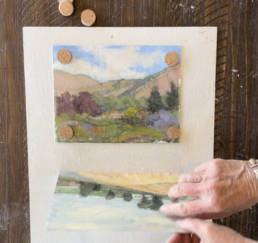
Is selling your art a difficult activity? Is it the part of ‘art’ you don’t want to think about? This article will explore 7 ways to have fun selling your art.
Guest author: Doug Farrick
It’s no big secret that some artists look upon ‘selling art’ as distasteful or greedy – the last thing anyone would want to do.
Why is this so? Well, the salesman stigma is everywhere. It’s in the culture, in the movies (Wall Street, Glengarry Glen Ross, Fargo, etc.), it’s in the books (Death of a Salesman), and it’s on TV. It has been portrayed as the lowest rung on the social ladder – the greasy-haired used-car salesman.
It’s no wonder selling your art is so uncomfortable! Many people (and Artists in particular) don’t even want to deal with selling or commerce or the global marketplace. They hate selling.
But, what if we “re-framed” selling art as something fun and even joyful? Is it possible to have fun (and even joy) when talking about and selling your art or program or product or whatever you have created? I think so. I really do.
“Re-frame” your approach toward art sales with these 7 Ways to Have Fun Selling Your Art
1. Practice sales and selling – Art sales just don’t happen. You have to “create” them, and you create art sales by having conversations. Have more conversations to potential clients and you’ll most definitely have more sales. Also, set up a climate so you can sell. Make it fun! Set up charts, have a huge goal board, commit to contacting x number of people per day, make a game out it, etc. Set up an environment so you can really put power into your performance on a consistent basis.
2. Move the sales process along – Have a clear vision of the steps a client needs to take once they are interested and want to move forward. Have that part of the process rehearsed and totally choreographed. Don’t have them go away and think about it. Say, very matter of faculty,“This is what you need to do next . . . get the deposit, then this happens, then this, etc. etc.” Move them along quickly.
3. Don’t be afraid of client questions – Let’s face it you’re GOING to get questions, concerns, etc. Questions are a good thing. They help you explore and give you insight into where the customer is at. It’s information that can help you zero in on the value you can provide. By creatively listening you can provide greater service to the client by customizing and tailoring your product to their specific needs.
4. Don’t be afraid to ask questions – Ask questions help you zero in on what your potential art client wants (or doesn’t want) Don’t be afraid to be direct and honest. For example, questions like “What do you see?” “What is that I’ve shared with you that you have interest in” “What do you hesitate about?” “What do you see value in?” Let the client start to move the conversation towards greater value for them.
5. Focus on what you have to give – it’s easy to feel like you are conning someone or you’re not totally congruent when you’re thinking about your commission or what you’re going to get out of the sale. Focus totally on service Meaning focus on them NOT you). How can you best serve this person (or organization) by providing them with the most amazing art ever (yours!) View your phone call to them as a benefit to THEM. They never would have found out about your stunning art if it wasn’t for you sharing it with them. Come from service and everything will magically fall into place.
6. Help your potential clients “see” the future – As artists we really help “paint” a picture of what your art or service or product will be like to them in the future. This is where, we, as artists can really use our artistic sensibilities to our advantage. Help them feel the good feelings, help them “see” the pictures on the wall and the beauty and harmony that will result. By changing ones relationship to time you help your clients make different decisions.
7. Don’t worry about closing – Closing (the end of the sale) is often seen as the real hard part, that is, when you have to initiate a YES or a NO. A lot of people don’t like that feeling. But actually if you have shown (or “painted’) the vision for your potential client “the close” almost happens by itself because at that point the are probably saying “So how can we move forward with this?” or “What do I have to do next?”
Practice these on a regular basis and you’ll soon be looking forward to your next conversation(s) about sales of your work – and have fun selling your art!
*****
Thanks to Douglas Farrick for sharing this insightful post. Doug is the owner of the Art Marketing Association ,an organization dedicated to helping artists sell more art and manage their careers more effectively through up-to-date information and resources.
PS. Let’s meet on Twitter, Facebook and now on Google Plus! http://gplus.to/lorimcnee …and if you want to see my paintings, please visit LoriMcNee.com ~Lori








I think these tips apply to many of us in the arts as well as creative arts therapists. Thanks for sharing!
Hello, great article !
I took it on my website and translate it in french. Of course, i quote the author and finearttips.
It’s always good to read you.
Lisa from http://www.artdeco-online.com/ !
Hello Lisa, thank you for letting me know. I am honored you are sharing this in your beautiful French language. Thank you for the nice words.
Lori 🙂
Although I’ve made thousands of calls to build and develop the client base of my hisband’s promotional products wholesale business from ground zero, I still find it hard to sell my own paintings.
It somehow feels… not right. I just feel that if people like it enough, they would buy?